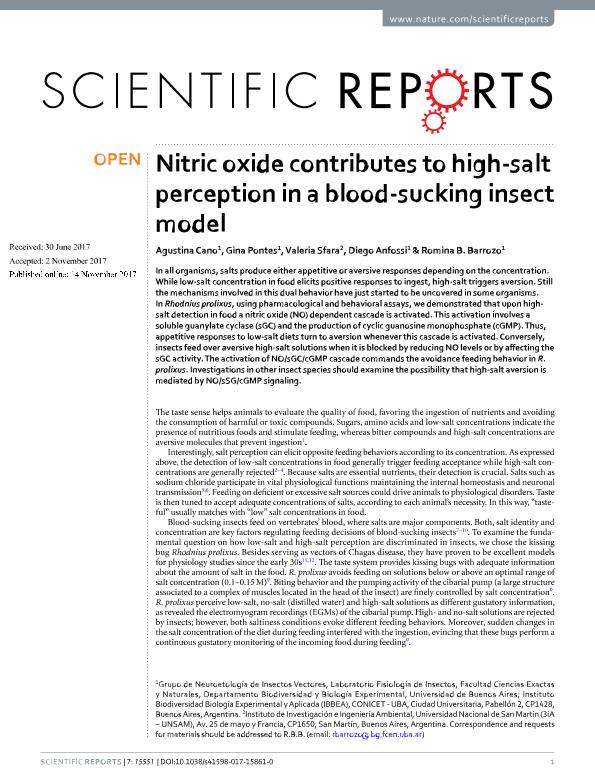Artículo
Nitric oxide contributes to high-salt perception in a blood-sucking insect model
Fecha de publicación:
11/2017
Editorial:
Nature Publishing Group
Revista:
Scientific Reports
e-ISSN:
2045-2322
Idioma:
Inglés
Tipo de recurso:
Artículo publicado
Clasificación temática:
Resumen
In all organisms, salts produce either appetitive or aversive responses depending on the concentration. While low-salt concentration in food elicits positive responses to ingest, high-salt triggers aversion. Still the mechanisms involved in this dual behavior have just started to be uncovered in some organisms. In Rhodnius prolixus, using pharmacological and behavioral assays, we demonstrated that upon high-salt detection in food a nitric oxide (NO) dependent cascade is activated. This activation involves a soluble guanylate cyclase (sGC) and the production of cyclic guanosine monophosphate (cGMP). Thus, appetitive responses to low-salt diets turn to aversion whenever this cascade is activated. Conversely, insects feed over aversive high-salt solutions when it is blocked by reducing NO levels or by affecting the sGC activity. The activation of NO/sGC/cGMP cascade commands the avoidance feeding behavior in R. prolixus. Investigations in other insect species should examine the possibility that high-salt aversion is mediated by NO/sSG/cGMP signaling.
Palabras clave:
Taste
,
Feeding
,
Hematophagous Insect
,
Nitric Oxide
,
Salt
,
Electromyograms
Archivos asociados
Licencia
Identificadores
Colecciones
Articulos(IBBEA)
Articulos de INSTITUTO DE BIODIVERSIDAD Y BIOLOGIA EXPERIMENTAL Y APLICADA
Articulos de INSTITUTO DE BIODIVERSIDAD Y BIOLOGIA EXPERIMENTAL Y APLICADA
Articulos(SEDE CENTRAL)
Articulos de SEDE CENTRAL
Articulos de SEDE CENTRAL
Citación
Cano, Agustina; Barcelos Pontes, Gina; Sfara, Valeria; Anfossi, Diego; Barrozo, Romina; Nitric oxide contributes to high-salt perception in a blood-sucking insect model; Nature Publishing Group; Scientific Reports; 7; 1; 11-2017; 1-9
Compartir
Altmétricas




